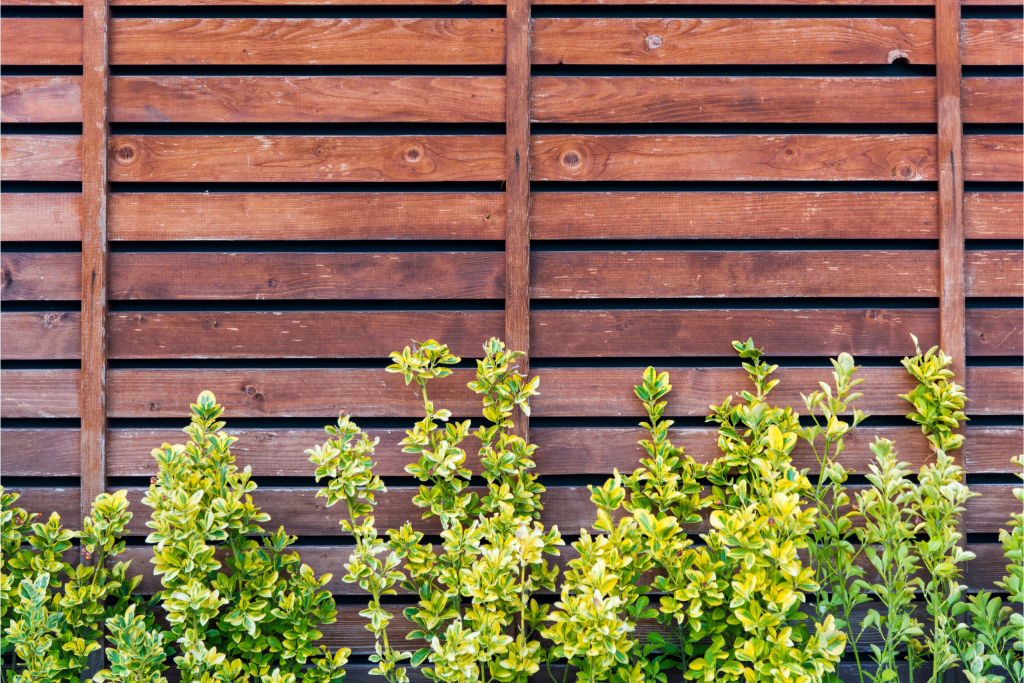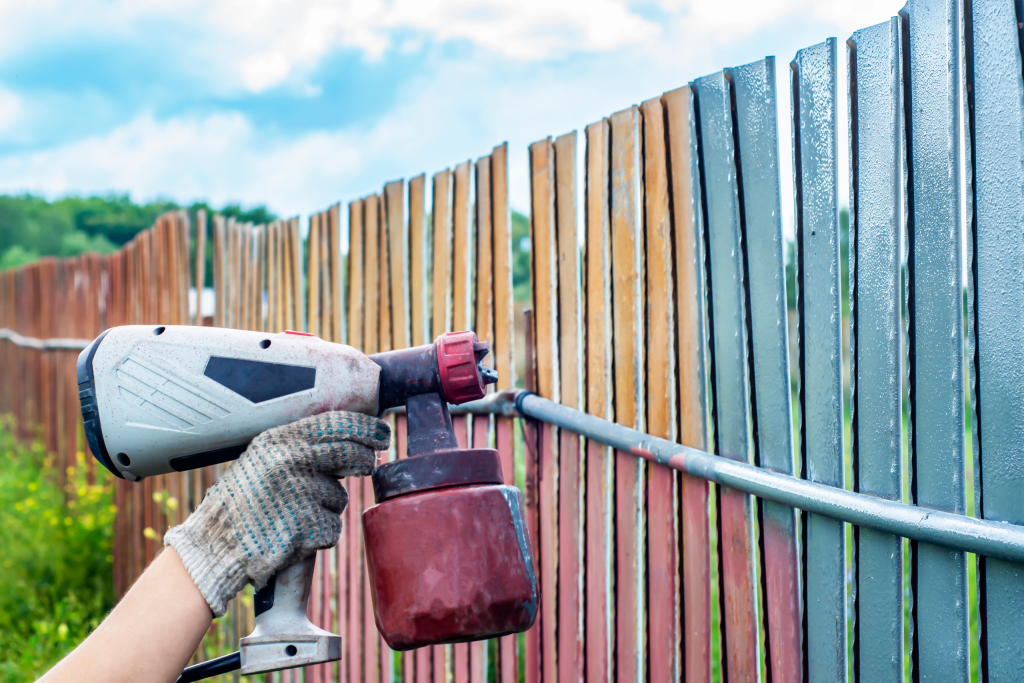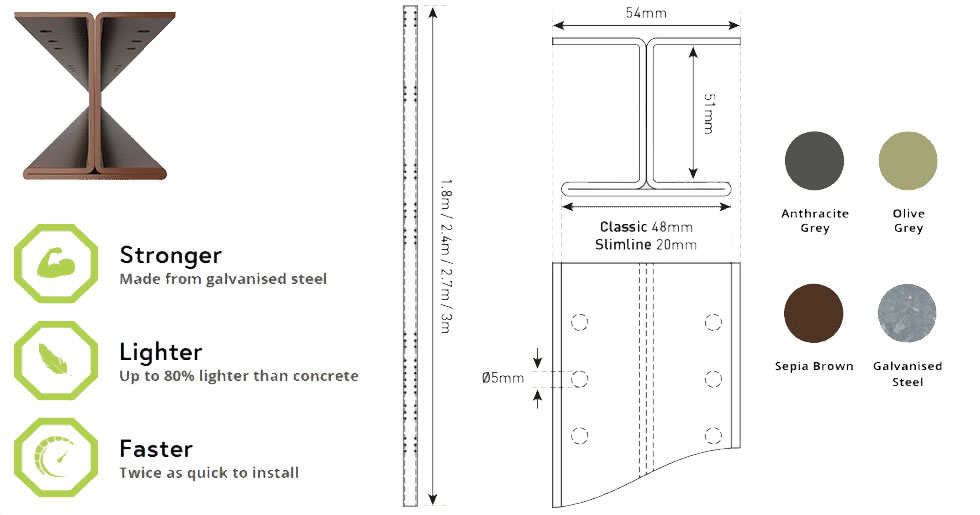Summertime is not far away, meaning that inevitably we will all be out in our gardens far more to enjoy the sunshine. BBQs with family, tending to flowers and plant beds or just relaxing on your favourite deck chair, for most your garden becomes a lively activity hub throughout the summer months, meaning that you want it to look its absolute best.
Typically this means mowing the lawn, trimming the hedges and jet-washing the patio.
Whilst this all goes a long way towards perfecting your plot, people often forget all about their fencing.
Why would my fence need a refresh?

Consider this; throughout the autumn and winter seasons your garden fencing is being relentlessly worn by the elements, meaning when spring and summer come around your once fresh wooden fencing can be left looking weathered.
A reinvigorated fence can uplift the entire aesthetic of your outdoor space.
Whether this means a complete panel replacement or just a refresh, Grangewood Fencing has everything you need to take your fencing from drab to divine.
For a complete fencing overhaul, we stock an extensive selection of high-quality Wooden Fence Panels available in a range of heights.
Alternatively, if you just want to breathe new life into your existing fencing, follow the steps below and we’ll have you summer ready in no time.
What Will You Need?
Refreshing or painting a fence can seem like a daunting task, especially for larger gardens, but the correct tools and accessories will make the whole process far more easy and efficient.
Before you get started, here are the essentials:
- Exterior wood primer
- Exterior wood paint or stain
- Plastic sheets
- A stiff brush for removing dirt.
- Fence spray gun or Ronseal Fence Life Brush.
- Protective face mask

Step 1 – Preparation
Before applying any primer, paint or stain to your fencing you will first need to protect the area; any nearby grass, plants or garden furniture using plastic sheets and moving any obstructions.
For overhanging branches or hedges, fencing solutions can be harmful so you will need to either trim these back from your fence or pin/tie them back until everything is dry and the work is complete.
Step 2 – Optimise the surface
To ensure the best overall coverage and that the wooden panels properly absorb any stain or primer you will need to rid your panels of any dirt, old nails and mildew. This can be done either manually or by using a power washer for any stubborn areas (bear in mind if you are using a washer, you will need to allow adequate time for the panels to dry).
If you are painting a fence that has been painted previously but is now flaking and untidy, you will want to sand your panels to ensure an even surface with a professional-level finish.
Step 3 – Apply your first coat
Best check the weather forecast beforehand as you will need a warm, dry day with no rain or wind.
If you plan on applying paint to your fence, you will first need to apply a primer using a brush or roller. This will serve as an adhesive for your paint and also help to prevent any mould growth. Allow any primer to dry for as long as the tin recommends, which is typically a few hours.
You can then begin either spraying or brushing your chosen exterior wood paint.
If you are using a fence treatment solution to provide protection and colour you can begin either spraying or brushing on your chosen stain.
It is important to remember that when using a brush, apply a good amount of stain to your brush and apply a thick coat that isn’t stretched too far.
Ronseal Fence Life Plus from Grangewood Fencing is:
- Suitable for both spraying and brushing application on either rough-sawn or smooth-planed fences
- Rainproof in just one hour
- Offers up to 5 years of protection
All done!
And there we have it, a beautiful garden border that you can be proud of!
All that is left to do now is clean up, remove any plastic sheets, return your garden furniture to its original location and clean any brushes using warm, soapy water.
Top 5 Garden Trends for 2023
With each passing year, gardening trends come and go. Some are fleeting, while others stick around for decades at a time. We’re going to look at five of the most popular trends in gardening right now and how they might impact your garden design plans for the future. From vertical gardens to modern features made from natural materials (like stone or wood), these ideas are sure to make an impact on your garden for years to come!
Vertical gardening

Vertical gardens are a great way to maximise space, whether you’re trying to fit a garden into an urban environment or just want to make the most of a small garden. Vertical gardens can be used indoors or outdoors, so they’re perfect for people who want to grow plants but don’t have access to any natural sunlight.
There are so many different ways to incorporate vertical elements into your garden. Trellis has long been used to grow climbing plants, however, we’re seeing increasing creativity as this trend grows. With people using horizontally slatted fencing and structures built from pallets to hang smaller plants, to complex irrigation systems being installed on walls for growing fruit and vegetables. The possibilities are endless!
Outdoor kitchens and lounges
Outdoor kitchens and lounges have become a popular addition to home gardens. These spaces can be used for cooking, dining and entertaining guests. Outdoor kitchens can be designed to fit into any space and can be customised based on the needs of your family or guests. Many people choose to erect a pergola to really turn the space into a feature. Pergolas are ideal for adorning with climbing plants, outdoor lighting and a multitude of other accessories.

Common features of an outdoor kitchen include a barbeque or pizza oven, countertop with seating, sink and bar area. Outdoor kitchens and lounges aren’t just great in the summer – they can also make a fun entertaining area in cooler months! With the simple addition of a fire pit or patio heater, you’ll really be able to make the most of this space for much of the year.
Modern features made of natural materials, such as stone and wood
As sustainability continues to gain momentum in so many aspects of our lives, 2023 will see an increase in sustainable, natural materials used in gardening. The use of hard landscaping and the materials involved can come with heavy carbon footprints.
“Cement – used to make concrete – contributes almost 1kg of carbon dioxide for every 1kg produced, although some is reabsorbed as concrete is exposed to the air. Bricks add 250g per 1kg, and every square metre of stone patio adds about 47.5kg of carbon dioxide, depending on the stone.”
As well as their environmentally friendly nature, the versatility of natural materials also makes them a popular choice. Used for everything from seating and tables, to stepping stones and raised beds, you can really get creative./
Container gardens
Whether you’re working with a small or large garden, or even just a patio or balcony, container gardening offers great flexibility when it comes to growing opportunities.
Container gardens are an excellent way to add colour and texture to your garden space. They’re also very easy to maintain as they don’t require much watering or pruning unlike other types of gardens.
A whole host of plants can be grown in containers, from hardy bedding plants to bulbs, herbs, fruit and vegetables and even shrubs and trees.
Pops of colour
Adding a pop of colour to your garden can really give it some personality. After all, gardens are meant to be colourful!
With Pantone naming Viva Magenta as their colour of the year 2023, why not add a splash to your garden? There are so many places to add colour, such as:
- Flowers and plants
- Containers and accessories
- Furniture
- A feature fence
Which 2023 trend will you incorporate into your garden?
Now we’ve given you some inspiration to take into Spring, which one will you be incorporating in your garden? The trend we’re most excited about is vertical gardening as it allows you to grow more plants in less space, and adds levels to your garden as they’re visible from above ground level. This can be done with trellis, or even just poles stuck into the ground with netting attached so that they support climbing vines like cucumbers or tomatoes.
FENCEMATE DuraPost – A Revolutionary New Fencing System
Made of galvanised steel, the FENCEMATE DuraPost System creates durable fencing that is quick to install. DuraPost is suitable for all the jobs where you might have used concrete or timber posts. The system is compatible with virtually all types of timber fencing panels including feather board, hit and miss, European panels and close boarded fencing.
What types of jobs is FENCEMATE DuraPost suitable for?
DuraPost is suitable for all the jobs where you might have used concrete or timber posts.
Why does DuraPost come with a continuous run of holes?
The continuous run of holes provided on the DuraPost allows you to fix your fence panel or gravel board from the rear of the post. The holes make it easier to construct your fence, particularly when building on a slope.
Which types of fencing is DuraPost suitable for?
DuraPost is suitable for virtually all types of timber fencing panels including feather board, hit and miss, European panels and close boarded fencing. The post can be used for post and rail fencing but is not designed for any type of wire fencing systems.
Is DuraPost really up to twice as quick as concrete to install?
A test was carried out using independent professional contractors. This demonstrated that the time taken to fit fence panels with DuraPost took only half the time in terms of man-hours when compared to concrete posts. One person was able to carry out the tasks normally requiring two people because DuraPost is so much lighter and easier to use than concrete posts.
Does FENCEMATE DuraPost really withstand high winds?
Yes. The product underwent independent testing at the Building Research Establishment and proved to withstand wind speeds in excess of 70MPH.
How sustainable is FENCEMATE DuraPost?
DuraPost is made from steel which is a sustainable material and can be infinitely recycled.
FENCEMATE DuraPost – Technical Specifications
FENCEMATE DuraPost – Installation Instructions
Step 1:
Set your first post into the ground using Rapid Set Fence Post Concrete and check the height. Dig the next hole. You can now position the gravelboard at the correct height and checked for level.
Step 2:
Slide your fence panel into the first post and secure with screws. Position your second post, check for alignment and set into the ground.
Step 3:
Fix capping rail and post caps if required.
You can find the full range of FENCEMATE Durapost products on our website.
The Forest Stewardship Council runs a global forest certification system with two key components.
Forest Management
Forest Management Certification, which makes sure that the forest is managed to high standards covering social, environmental and economic issues.
Chain of Custody
Chain of Custody certification, which traces the wood from those forests through all stages of processing and distribution. Chain of Custody certification from forest to end-user ensures that FSC materials and products have been checked at every stage of processing so that customers purchasing FSC labelled products can be confident that they are genuinely FSC certified.
The 10 Forest Stewardship Council Principals
Compliance with Laws and FSC Principles
To comply with all laws, regulations, treaties, conventions and agreements, together with all FSC Principles and Criteria.
Tenure, Use Rights and Responsibilities
To define, document and legally establish long-term tenure and use rights.
Indigenous Peoples’ Rights
To identify and uphold indigenous peoples’ rights of ownership and use of land and resources.
Community Relations and Worker’s Rights
To maintain or enhance forest workers’ and local communities’ social and economic well-being.
Benefits from the Forest
To maintain or enhance long-term economic, social and environmental benefits from the forest.
Environmental Impact
To maintain or restore the ecosystem, its biodiversity, resources and landscapes.
Management Plan
To have a management plan, implemented, monitored and documented.
Monitoring and Assessment
To demonstrate progress towards management objectives.
Maintenance of High Conservation Value Forests
To maintain or enhance the attributes which define such forests.
Plantations
To plan and manage plantations in accordance with FSC Principles and Criteria.
For more information about the Forest Stewardship Council please visit them at www.fsc-uk.org/en-uk



